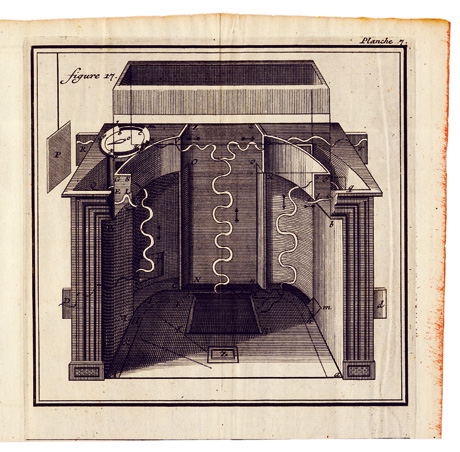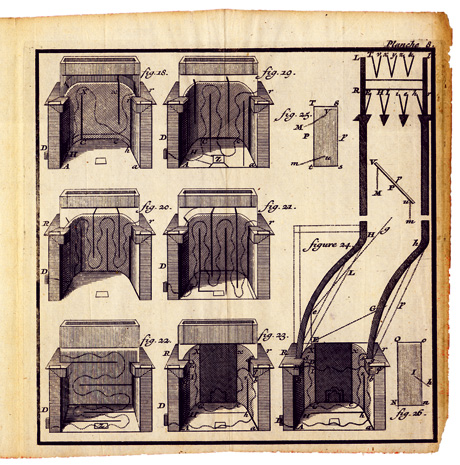The Rational Hearth
Gauger, Descartes, and the Vestal Complex
Frumento Combusti
In his 1637 treatise on optics, La Dioptrique, the French philosopher, mathematician, and cosmologist René Descartes concerned himself at some length with the problem of the “anaclastic,” a general term for the geometry of lenses and mirrors capable of effecting (at least in theory) a perfect focal point. His innovative solutions, which involved elaborate constructions of conic sections (and elegant proofs of some thorny theorems), were not only essential to the development of telescopes and microscopes for more than a century, they also embodied the spirit of the new sciences—those mechanico-mathematical reconstructions of nature that birthed modernity in the seventeenth century.
Steeped in Latinity, Descartes would have been well aware that the word focus secreted in its etymology the primordial centering point of civilized life: the hearth (Lat. focus). It might have surprised him, however, had he lived long enough to see his optical methods for calculating foci mobilized for the purposes of “hearth-craft” by an idiosyncratic Cartesian disciple, the Parisian jurist and tinkerer Nicolas Gauger, whose Méchanique du Feu of 1714 is a most unlikely hybrid: a masonry handbook that keeps lapsing into a metaphysical treatise on thermodynamics and domesticity.
Much as the English “practical Newtonians” of the eighteenth century churned out reams of dodgy pamphlets that applied their hero’s law of gravitation to everything from animal husbandry to cardsharping, “practical Cartesians” like Gauger, inspired by the ésprit géometrique, took up the ancient nuisances of the smoky fireplace and the icy bedchamber, confident that Descartes’s analytical tools could provide heat, not merely light.
Reasoning that heat traveled in rays that obeyed the laws of optics, Gauger advocated parabolic fireplaces that would, in his analysis, optimally redirect emergent heat rays out into the room. Standardized log-lengths were essential to his fire-science, since the proper construction of a given hearth required that the geometrical focus and directrix of its parabolic sides be calculated with respect to the specific size of fire it would house.
But does fire actually behave like light? Without reference to an energistic conception of heat (which would only arise in the nineteenth century, in connection with studies of the efficiency of steam engines), Gauger was left to muse on the slippery nature of warmth, which sometimes acted like a ray, but at others like a pervasive fluid or breath. He called this latter form of heat “transpiration,” and outfitted his new fireplaces to breathe this aspect of fire gently into the room: an elaborate system of vents and ducts both fed the fire from below and circulated external air through a sequence of baffles around the firebox; once warmed, this heat-breath could blow out from mouths in the hearth stone.
Gauger touted his improved fire-mechanisms as something more than the rational taming of the ancient violence of flame, though they were certainly that. They were also, however, therapeutic devices, ideally crafted to improve health, sanitation, and domestic welfare. The ill, so in need of warmth, were gravely endangered by shutting themselves off from fresh air in sealed rooms, as were their attendants, who poisoned themselves slowly by rebreathing the exhalations of their wards. Worse still, the sick tended to bundle themselves against the pervasive drafts of poorly heated rooms, but this swaddling enclosed and concentrated their maladies. With Gauger’s new devices, rooms could be continuously heated by a gentle, adjustable stream of fresh, warm air, permitting bodies to be exposed, comfortable, and together—all without risk of infection or inconvenience of discomfort. The benefits would fall above all, of course, to women, whose delicate skin, sensitive eyes, and vulnerable complexions would be guarded from the insults of smoke and flame, draft and chill. Once understood as the essential tenders of the hearth, women were, by 1714, well on their way to being reimagined as hothouse flowers.
Having completed, in 1927, an exacting technical history of the science of heat propagation, the anti-positivist postmaster-turned-epistemologist Gaston Bachelard turned to the project that would become, a decade later, La Psychanalyse du Feu, a defiantly Jungian effort to reground scientific objectivity on the poetic discernments of our deep psychology. Writing there of what he called “The Prometheus Complex,” Bachelard recalled himself as an invalid, and his father as the primordial focarius, the first stoker, the mythic fire-man:
When I was sick my father would light a fire in my room. He would take great care in arranging the logs over the kindling chips and in slipping the handful of shavings between the andirons. To fail to light the fire would have been incredibly stupid. I could not imagine my father having any equal in the performance of this function, which he would never allow anyone else to carry out. Indeed, I do not think I lit a fire myself before I was eighteen years old. It was only when I lived alone that I became master of my own hearth.


For Bachelard, the Prometheus Complex was, as he put it, “the Oedipus Complex of the life of the intellect,” under which rubric he proposed to gather all those “tendencies which impel us to know as much as our fathers, more than our fathers.” Here the basic drama of civilization becomes a kind of competitive “quest for fire” in which knowledge is hearth-craft, and hearth-craft is, as it happens, patriarchy.
It is this last move that surprises. Patriarchy? But what has become of Vesta, the archaic keeper of the Olympian fire? Or, to put it a different way, what has become of the sexual drama that lies at the heart of the original Oedipus Complex? In transferring that drama to the realm of the (masculine) intellect, Bachelard sublimed it, burning off the taint of eros, erasing the oozy mess of woman-love, and reinventing the domestic drama as a tidy game of boys against boys.
How did women come, like sick boys, to sit by the fire, instead of tending it? This, in the end, is perhaps the real story of La Méchanique du Feu. After all, what could be a better answer to this question than the chronicle of the rise of domestic comfort, the mechano-architectural evolution of bourgeois domesticity? And Gauger, to be sure, merits more than a footnote in that history. But is this enough? What if we were instead to follow Bachelard, and sift beneath that plodding (if worthy) story of centralized heat and running water, slipping our fingers down into the first darkness to feel for the mind that has, as yet, no focus. In other words, what if we were to recover a psychoanalysis of domestic fire? We would discover, it seems, what we might call the “Vestal Complex,” under which designation can be gathered all those tendencies that impel men to replace “their” women with machines. The mechanical hearth, by these lights, becomes the prehistory of what Duchamp would eventually call the machine célibataire.
Which leads back, of course, to Descartes, who figured himself at the scene of his most profound discovery—at the moment of his regrounding of the Western philosophical tradition—as a focarius, attending on his overheated stove in a small and airless room. Only the Vestal Complex can explain the irrepressible rumor that has dogged his memory ever since: that using his new mechanical philosophy, he fashioned a refined automaton-daughter, Francine, and took her as his android-lover. Here was a solution to the anaclastic of desire; here we find a suitable keeper of the Cartesian flame. Picture her sitting comfortably beside the Gauger hearths reproduced in these pages.
The author would like to thank Daniel Zauber for his contributions to this essay.
Frumento Combusti was born in France and is a principal in Los Gallos, LLC, a company based in Colorado. He is working on a history of the nineteenth-century Russian-Jewish colony of Cotopaxi, on the Arkansas River.
Spotted an error? Email us at corrections at cabinetmagazine dot org.
If you’ve enjoyed the free articles that we offer on our site, please consider subscribing to our nonprofit magazine. You get twelve online issues and unlimited access to all our archives.